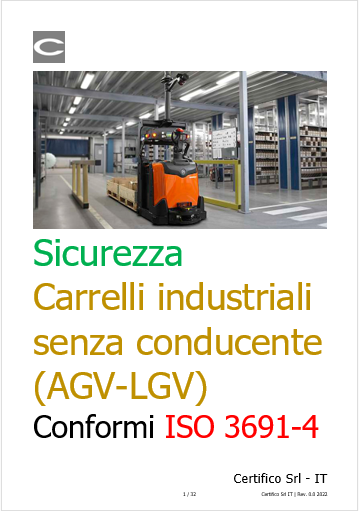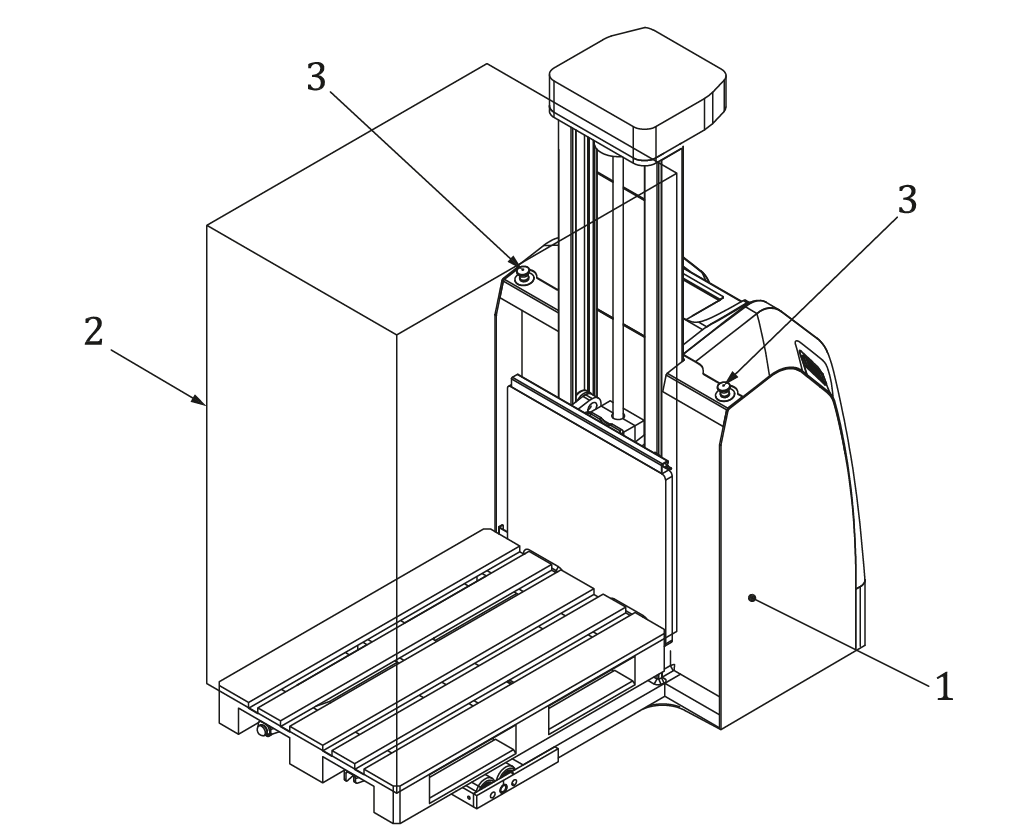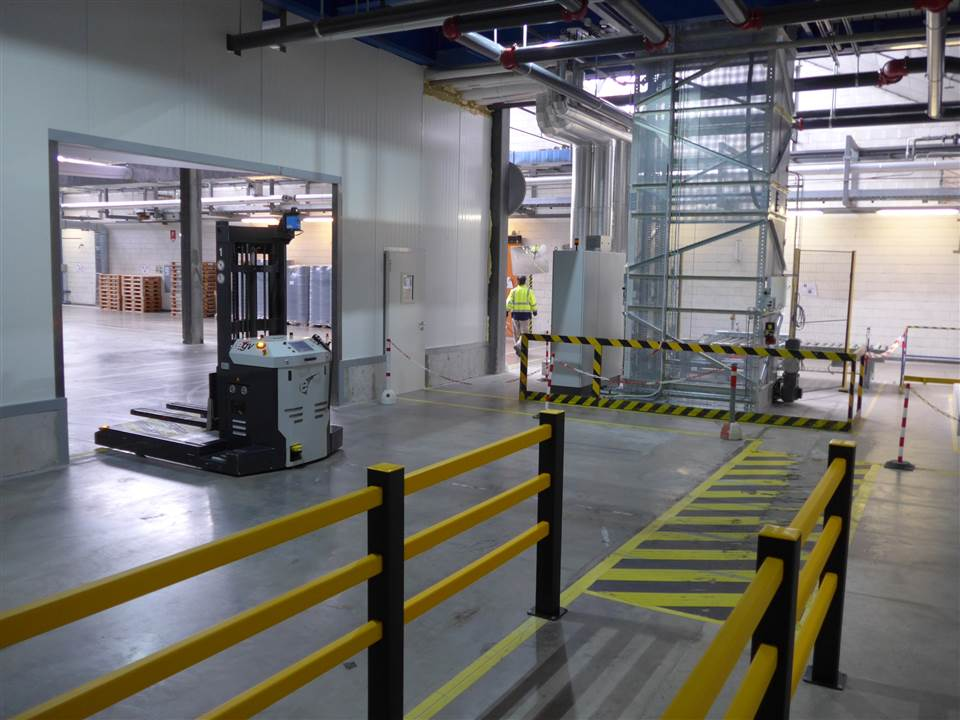Sicurezza Carrelli industriali senza conducente (AGV-LGV) conformi ISO 3691-4:2020
| Appunti Normazione | ||
| 27 Giugno 2025 | ||
| Salve Visitatore | ||
Sicurezza Carrelli industriali (AGV-LGV) conformi ISO 3691-4:2020 ID 15477 | 17.01.2022 / Documento completo allegato Documento sulla sicurezza per l’uso dei sui carrelli industriali senza conducente a bordo AGV/LGV, con: UNI EN ISO 3691-4:2020 La norma specifica i requisiti di sicurezza e i mezzi per la loro verifica per i carrelli industriali senza guidatore e i loro sistemi. La norma, che ha sostituito integralmente la EN 1525:1999, è tipo di tipo C ed è il riferimento per la sicurezza dei carrelli industriali senza conducente. La norma, alla Data del Documento, non è armonizzata per la Direttiva macchine 2006/42/CE. Vedi tutte le norme armonizzate Direttiva macchine 1. Note principali norma La norma definisce in generale la sicurezza degli AGV/LGV e delle aree/impianti asserviti da AGV/LGV ZONA OPERATIVA PERICOLOSA: Deve essere evitata confusione con altri segni e segni. In questa zona di pericolo operativo, la velocità del carrello deve essere conforme alla tabella A.1 e alla tabella A.2 e il carrello deve emettere avvisi acustici e/o ottici aggiuntivi. Se c'è spazio libero insufficiente e nessuna via di fuga pedonale di almeno 0,5 m di larghezza e 2,1 m di altezza (vedi Tabella A.1 e Tabelle A.2, C.1, C.2 e C.3 dimensioni di ingombro), i mezzi di rilevamento del personale devono essere attivi per garantire il rilevamento di persone entro 180 mm tra il bordo dei campi di sicurezza dell'ESPE e gli oggetti circostanti al fine di verificare che questa zona sia libera da persone (ad esempio depositi a blocchi). ESEMPIO ESEMPIO La zona ristretta deve: a) essere chiaramente contrassegnata da segnaletica e segnaletica orizzontale a terra; ZONA CONFINATA: La zona confinata deve: a) essere chiaramente contrassegnati da segnaletica e segnaletica orizzontale/terra; 2. Estratto norma UNI EN ISO 3691-4:2020 (EN) 4.7 Stability 4.7.1 General The truck shall remain stable in all operating conditions and during all load-handling and travelling movements, including an emergency stop. 4.8.1 Emergency stop Trucks shall be provided with an emergency stop function that complies with ISO 13850:2015. When the emergency stop device is actuated, all truck movements shall stop. The emergency stop devices shall be clearly visible, identifiable and accessible from both ends and both sides of the truck. If the truck has a defined operator position with controls, an emergency stop device shall be fitted near these controls. However, in the case of trucks carrying a load that restricts access to the emergency stop device(s), the emergency stop device(s) shall be mounted on accessible rigid part(s) of the truck closest to the hazard zone (see Figure 2, for example). The safety-related parts of the control system for emergency stop function shall be in accordance with Table 1, item 15. NOTE Key 4.8.2 Detection of persons in the path 4.8.2.1 Detection of persons in the intended path in automatic mode The safety-related parts of the detection of persons in the intended path in automatic mode shall be in accordance with Table 1, items 4, 16, 17 and 20. Trucks shall be fitted with personnel detection means, the following requirements apply. a) Trucks shall be fitted with pressure-sensitive device according to 4.1.11 (e.g. bumpers) or ESPE (e.g. virtual bumpers) according to 4.1.10 for the detection of persons. NOTE 1 6.2 Warning systems The warning systems shall comply with ISO 12100:2010, 6.4.3. When the truck starts any movement after a stop condition longer than 10 s, a visible and/or acoustical warning signal shall be activated at least 2 s, prior to the start of any movement, including any moving part of the truck (e.g. forks, conveyors, parts protruding from the load). A visible and/or acoustical warning signal shall be active during any movement, including any moving part of the truck (e.g. forks, conveyors). This signal may be the same signal as the prior to the start warning signal. If personnel detection means are not active, the visible and/or acoustical warning signal shall bedifferent than the prior to the start and moving signals. The visible and acoustical signal shall be designed taking into account the environmental conditions (e.g. noise, light, brightness). When the truck changes its travel direction from a straight path, a visible indication of the direction to be taken shall be given (e. g. turning signals) prior to the change of direction. Annex A (normative) Requirements for preparation of the operating zones A.1 General This annex establishes minimum requirements for the preparation of the zones so that the truck(s) can safely operate. When a truck travels along a continuous fixed closed structure preventing persons from entering or reaching into the path, speed and other data in Table A.1 shall be applied. When a truck travels near to a fixed structure or an object different from continuous fixed closed structure preventing persons from entering or reaching into the path, truck speed and other data in Table A.2 shall be applied. See Figures A.1 and A.2 for examples of clearances. A.2 Zones A.2.1 Operating zone A minimum clearance of 0,5 m wide for a height of 2,1 m shall be provided on both sides of the path. This shall be measured between the path and adjacent fixed structures along the path. A.2.2 Operating hazard zone A zone of inadequate clearance (see A.2.1) or a zone which cannot be protected by personnel detection means shall be designated "operating hazard zone" (see Table A.1 and Table A.2) and marked accordingly. An operating hazard zone shall be clearly indicated by suitable signs or preferably floor/ ground markings. Confusion with other markings and signs shall be avoided. In this operating hazard zone, the truck speed shall be in accordance with Table A.1 and Table A.2 and the truck shall emit additional acoustical and/or optical warnings. If there is inadequate clearance and no pedestrian escape route of at least 0,5 m wide and 2,1 m high (see Table A.1 and Tables A.2, C.1, C.2 and C.3 clearance dimensions), then personnel detection means shall be active to ensure detection of persons to within 180 mm between edge of safety fields of ESPE and surrounding objects in order to check this zone is free of persons (e.g. block storages). EXAMPLE Table A.1 - Required zone classification and other requirements in areas with continuous fixed closed structures, considering clearances
Organizzazione delle vie di circolazione e dei posti di lavoro Capita raramente che i sistemi di movimentazione senza conducente lavorino in una zona «securizzata», delimitata in modo chiaro e netto e riservata solo a questi veicoli. Di solito questi veicoli operano negli stessi spazi in cui si muovono le persone e altri veicoli. Pertanto, possono crearsi varie situazioni critiche. Fig. 2: incrocio tra le corsie dei veicoli AGV e le zone dedicate ai pedoni In linea generale, si prediligono le zone usate in comune in quanto non sono riservate esclusivamente ai sistemi AGV; in questo modo le persone possono trovarsi nelle immediate vicinanze del veicolo automatizzato o sulle corsie di marcia. Certifico Srl - IT | Rev. 0.0 2022 Collegati |
||
|
|
||
 |
||
| www.certifico.com
è un sito di INVIO NEWSLETTTER Se vuoi cancellarti dall'invio della newsletter oppure effettua il login al sito ed entra nella Tua Area Riservata, in “Modifica dati” agisci con la spunta sul box di selezione “Newsletter”. L'Elenco completo di tutte le ns newsletter è qui: Archivio newsletter. |
||
  |
||
| Certifico Srl 2000-2025 | VAT IT02442650541 | ||





































